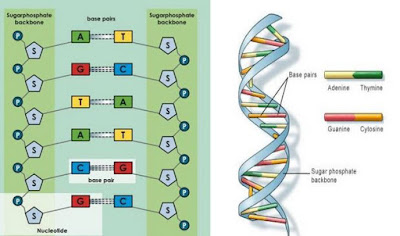A polynucleotide in a DNA molecule is made up of a series of nucleotides. Each nucleotide is composed of:
1. The deoxyribose sugar clusters (pentose sugars that lose an oxygen atom)
2. A phosphate acid cluster bound to the number 5 C atom of sugar)
3. A nitrogen base band attached to the 1st C atom of the sugar
The three clusters are interconnected and form a very long "backbone" of the double helix. The structure can be likened to a ladder, where the mother stairs are deoxyribose sugar and the ladder is a nitrogen base arrangement. While phosphate connects sugars to one nucleotide to sugars in the next nucleotide to form polynucleotides.
Picture of DNA Structure
The DNA nitrogen base comprising the purine base, adenine (A) and guanine (G), and the pyrimidine base is cytosine or cytosine (C) and thymine (T). The bond between pentose sugar and nitrogen base is called nucleoside. There are four kinds of nucleoside bases:
1. The A-sugar bond is called adenosine deoxyribonucleoside (deoxyadinosine)
2. The G-sugar bond is called guanosine deoxyribonucleoside (deoxyguanosine)
3. The C-sugar bond is called deoxyribonucleoside cytidine (deoxycytidine)
4. The T-sugar bond is called thymidine deoxyribonucleoside (deoxyribotimidine)
The acid-sugar-phosphate bond is referred to as deoxyribonucleotides or often called nucleotides. There are four kinds of deoxyribonucleotides, namely adenosine deoxyribonucleotides, thymidine deoxyribonucleotides, deoxyribonucleotide cytidine, thymidine deoxyribonucleotides. The nucleotides from a circuit called a polynucleotide. DNA is formed from two twisted nucleotide points.
The nitrogen bases on one thread have a fixed pair with the nitrogen bases on the other. Adenine is paired with thymine and guanine in pairs with cytosine. The base pairs of nitrogen A and T are connected by two hydrogen atoms (A = T). The base pairs of nitrogen C and G are connected by three hydrogen atoms (C≡G). Thus, both polynucleotides in one DNA complement each other.
In 1947, before the discovery of the molecular structure of DNA, a biochemist named Erwin Chargaff analyzed the DNA base compositions of a number of different organisms. The result of the analysis is that each species of organism has different DNA composition. The number of four nitrogen bases in each species is not the same but has a unique comparison. That is, each species has a unique number of bases.
In the DNA of each species examined, Chargaff argues that the amount of adenine is almost equal to the amount of thymine and the amount of cytosine is almost equal to the amount of guanine. In addition, the sequence of bases and DNA lengths in each species is different. With 4 basic bases and long DNA, there will be a possible sequence of bases. Because genes are composed of a particular base sequence, then the number of genes in DNA is also very likely. So, only with 4 different bases will form many genes that determine the nature of the individual.
